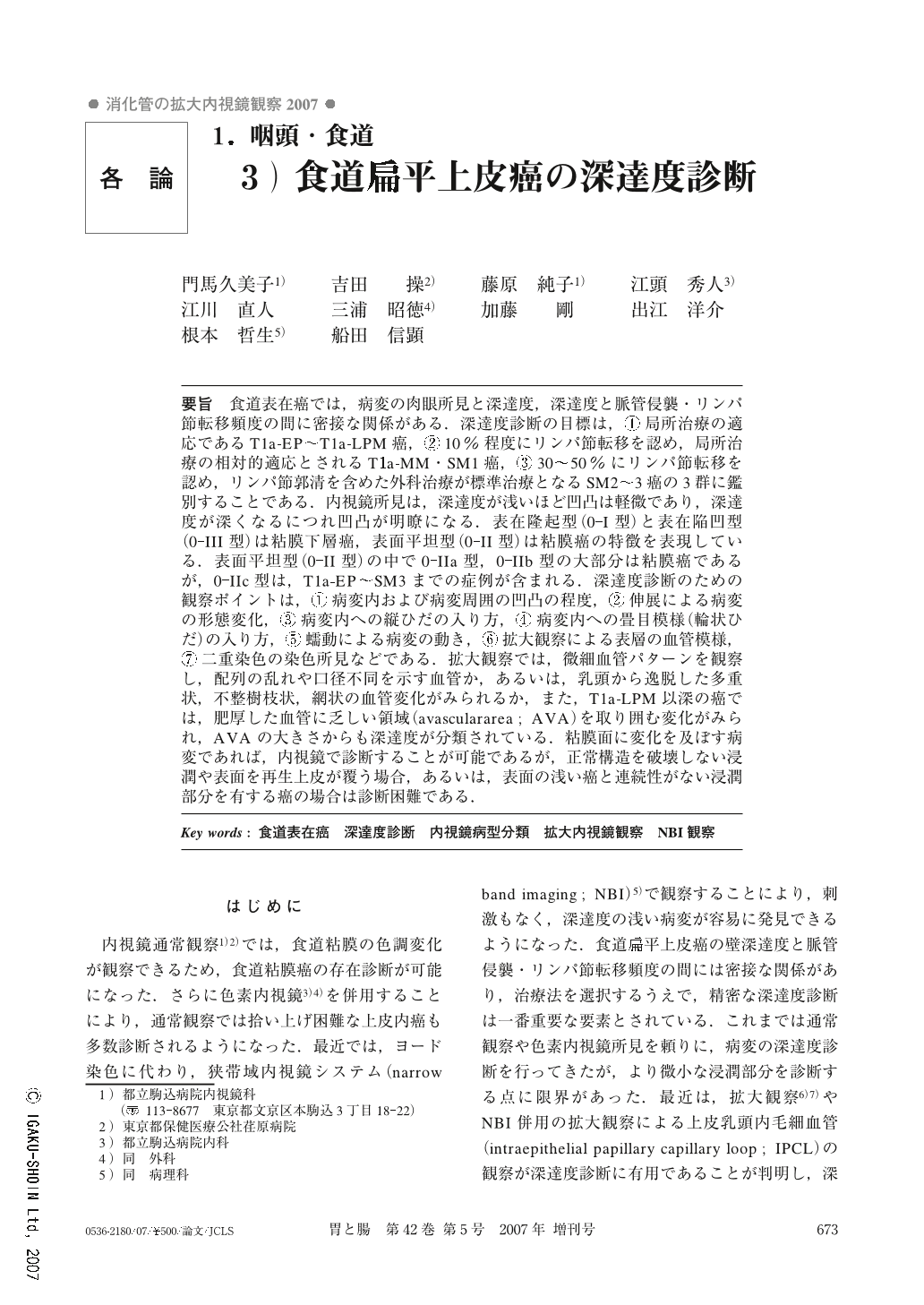Japanese
English
- 有料閲覧
- Abstract 文献概要
- 1ページ目 Look Inside
- 参考文献 Reference
- サイト内被引用 Cited by
要旨 食道表在癌では,病変の肉眼所見と深達度,深達度と脈管侵襲・リンパ節転移頻度の間に密接な関係がある.深達度診断の目標は,①局所治療の適応であるT1a-EP~T1a-LPM癌,②10%程度にリンパ節転移を認め,局所治療の相対的適応とされるT1a-MM・SM1癌,③30~50%にリンパ節転移を認め,リンパ節郭清を含めた外科治療が標準治療となるSM2~3癌の3群に鑑別することである.内視鏡所見は,深達度が浅いほど凹凸は軽微であり,深達度が深くなるにつれ凹凸が明瞭になる.表在隆起型(0-I型)と表在陥凹型(0-III型)は粘膜下層癌,表面平坦型(0-II型)は粘膜癌の特徴を表現している.表面平坦型(0-II型)の中で0-IIa型,0-IIb型の大部分は粘膜癌であるが,0-IIc型は,T1a-EP~SM3までの症例が含まれる.深達度診断のための観察ポイントは,①病変内および病変周囲の凹凸の程度,②伸展による病変の形態変化,③病変内への縦ひだの入り方,④病変内への畳目模様(輪状ひだ)の入り方,⑤蠕動による病変の動き,⑥拡大観察による表層の血管模様,⑦二重染色の染色所見などである.拡大観察では,微細血管パターンを観察し,配列の乱れや口径不同を示す血管か,あるいは,乳頭から逸脱した多重状,不整樹枝状,網状の血管変化がみられるか,また,T1a-LPM以深の癌では,肥厚した血管に乏しい領域(avasculararea;AVA)を取り囲む変化がみられ,AVAの大きさからも深達度が分類されている.粘膜面に変化を及ぼす病変であれば,内視鏡で診断することが可能であるが,正常構造を破壊しない浸潤や表面を再生上皮が覆う場合,あるいは,表面の浅い癌と連続性がない浸潤部分を有する癌の場合は診断困難である.
Estimation of cancer invasion into the esophageal wall is one of important issues in endoscopic diagnosis on superficial esophageal cancer. The depth of invasion has a close relationship with histological findings of micro vascular invasion and lymph node metastasis that we have to consider in selection of treatment. It is recommended that superficial esophageal cancers should be differentiated into three categories such as group-1: T1a-EP and T1a-LPM cancers for which localized treatments such as EMR are recommended, group-2: T1a-MM and SM1cancers that give a relatively high indication for EMR, because of low incidence of lymph node metastasis (10%) and group-3: SM2and SM3cancers that probably have lymph node metastasis in30~50%, so radical esophagectomy should be employed. Generally speaking, mucosal cancers show less irregularity while those with deeper invasion frequently present distinct elevation or depression, such as type0-I and type0-III lesions which represent submucosal cancer while type0-II indicates mucosal cancer. Mucosal cancers are frequent among type0-IIa and type0-IIb lesions. At the same time, type0-IIc lesions include mucosal cancers and some SM2and SM3cancers.
Endoscopic findings strongly suggesting deeper invasion are partial and distinct elevation or depression, persistent deformities despite extension of the esophageal wall, interruption of longitudinal folds or interruption of vertical mucosal folds, discrepancies of movement of the tumor and the muscle layer on peristalsis, abnormal findings of capillaries on magnifying observation and dark blue staining with endoscopic toluidine blue-iodine double staining. Magnifying endoscopy provided us with a new means for the estimation of cancer invasion : deeper invasion should be suspected when there is evidence of abnormalities in size and distribution of capillaries, and abnormal vessels suggesting stromal vessels of the tumor. A part of the cancer lesion that lacks in capillaries and is surrounded by abnormal and long vessels strongly suggests invasion into the muscularis mucosae or more (avascular area : AVA). The size of AVA also allows us to estimate the grade of deeper invasion. We have keep in mind the fact that cancer infiltration covered by normal mucosa or intraepitherial cancer probably show no abnormal findings on endoscopic observation.

Copyright © 2007, Igaku-Shoin Ltd. All rights reserved.


